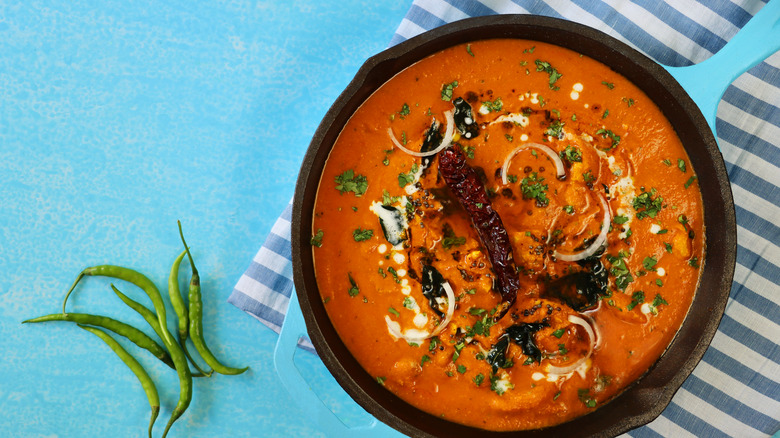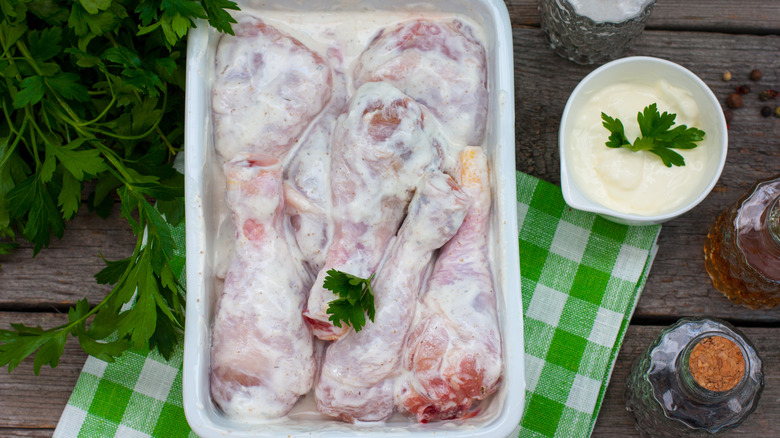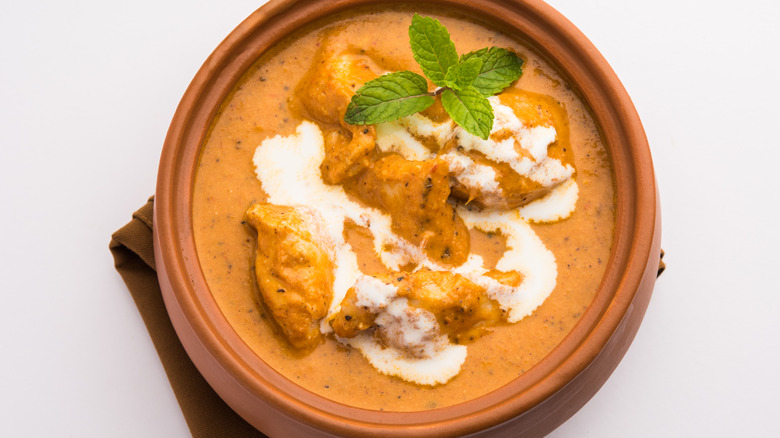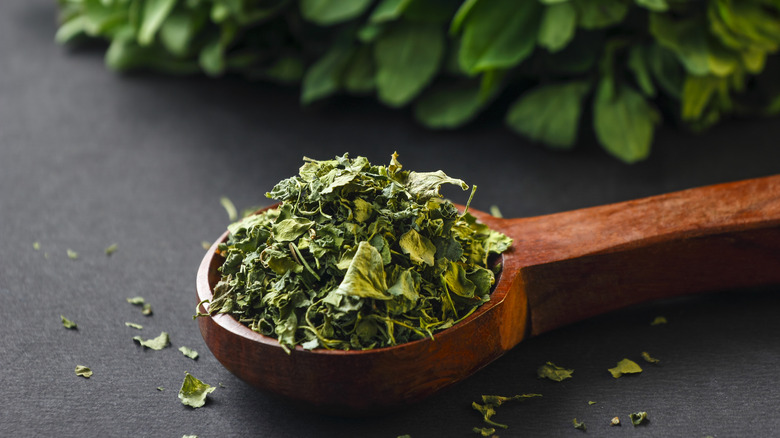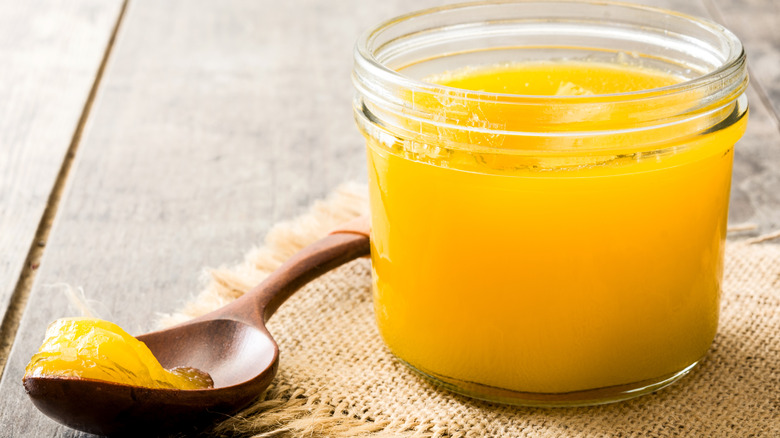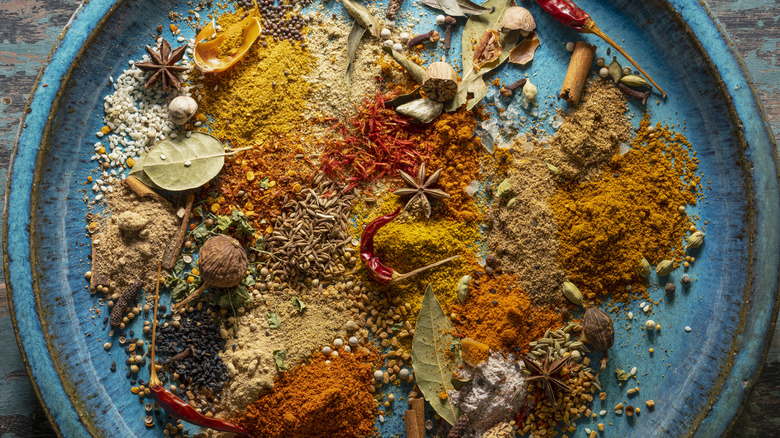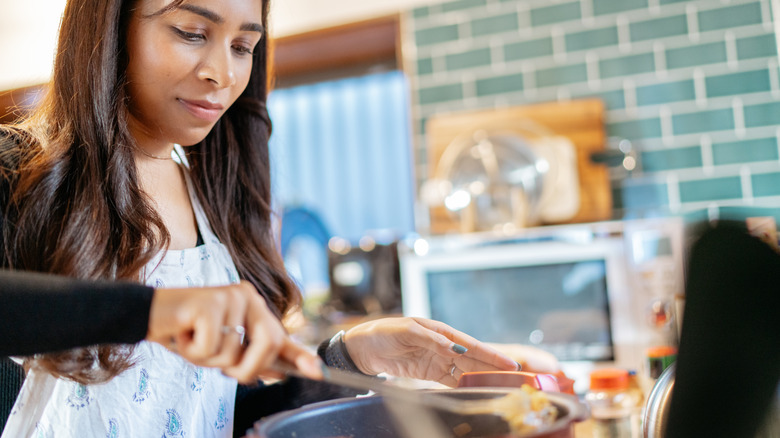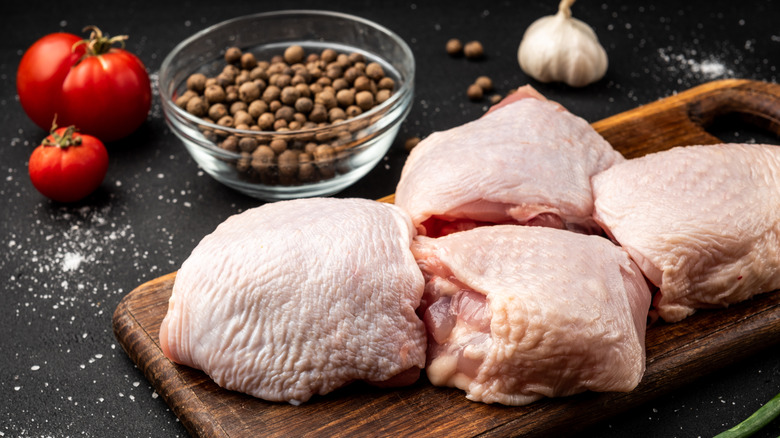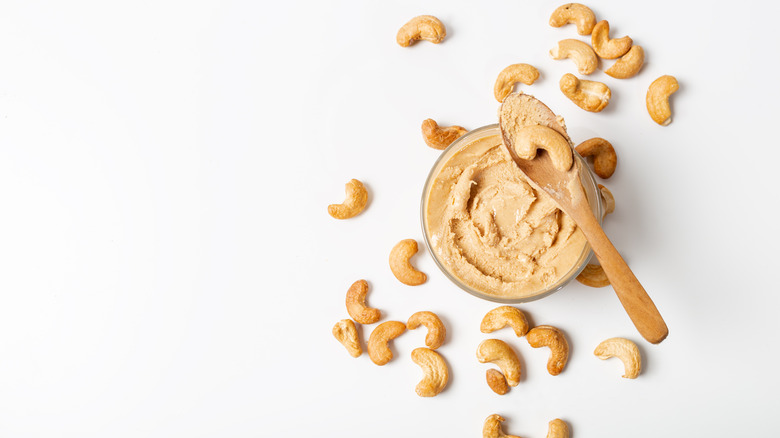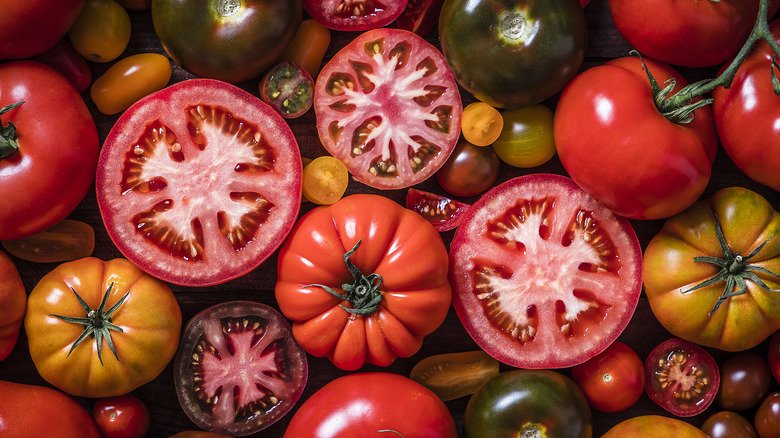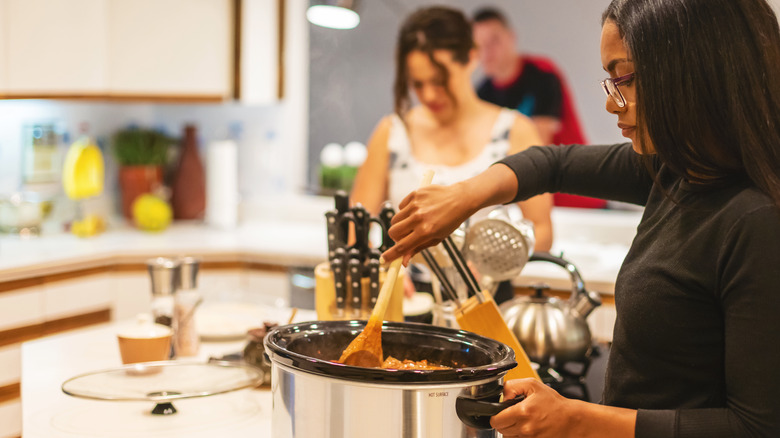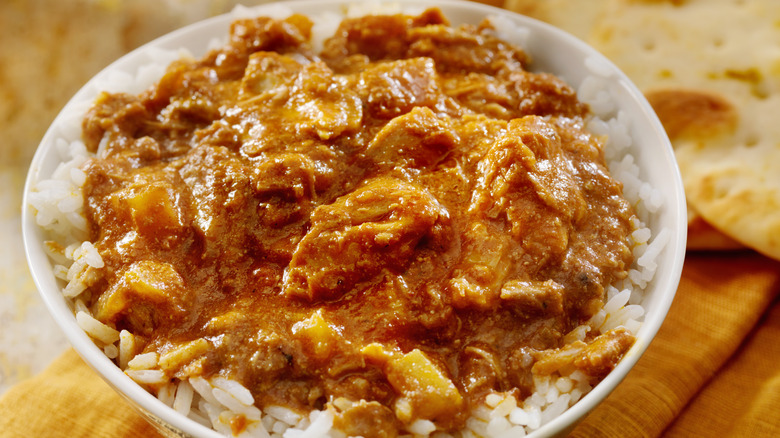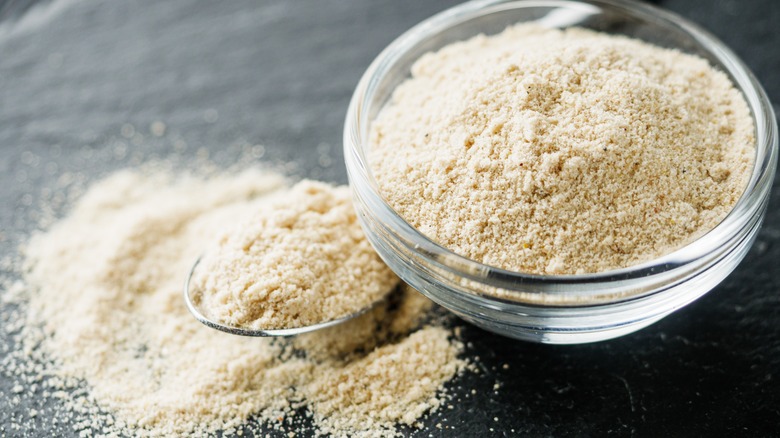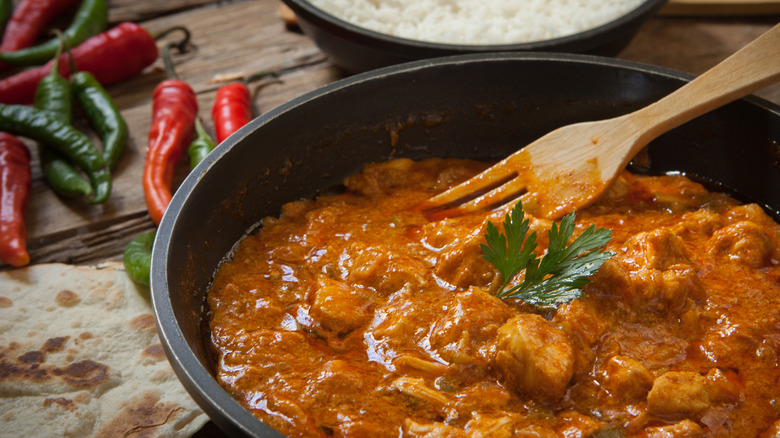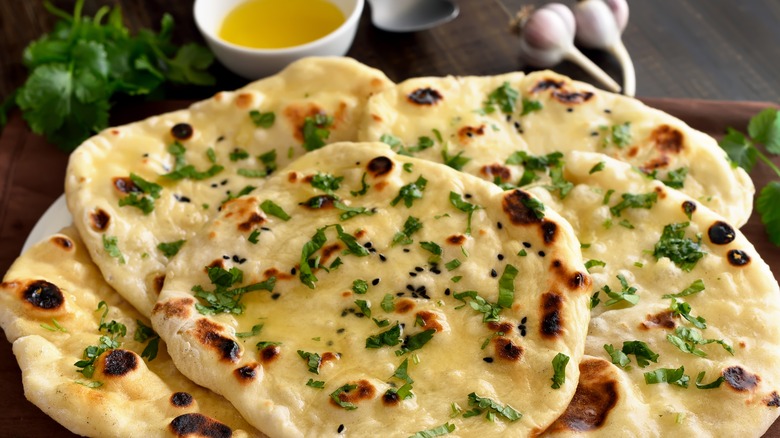15 Tips You Need When Cooking Butter Chicken
Creamy, fragrant, and flavorful — these are just a few words to describe Indian butter chicken, a curry dish originating in Delhi that boasts a sauce made with cooked fresh tomatoes and butter. The dish is also known as "murgh makhani." Butter chicken comes with a debated origin; some stories say it was the result of resourcefulness, and others believe it was an accidentally delicious creation derived from catering to a large party of refugees visiting the restaurant Moti Mahal.
Regardless of how the story goes, an important culinary contribution was made that day within the walls of the Moti Mahal — the birth of butter chicken. There are many ways to make a delicious butter chicken, such as using the right kind of cream to create a silkier sauce or adding fenugreek for a hint of herbal sweetness. Even grilling your chicken before adding it to your curry can give the dish a smokier, aromatic zing.
From small family-run restaurants across the globe to five-star, upscale restaurants, there is a wide variety of ingredients and methods that make the dish pop. Adding these tips to your apron back pocket ensures you always have a wide berth of knowledge with which to make the dish in your own kitchen. Butter chicken is a meal that can taste different each time you make it based on the ingredients you choose–and that is half the fun.
Marinate your chicken overnight in yogurt and spices
While butter chicken can be whipped up in a pinch, this "express" version won't get you the best butter chicken around. To really wow your guests, be sure to have the chicken sit for a yogurt marinade overnight. The secret? Choose full-fat regular yogurt, which is not as thick as Greek yogurt and can work very well for a creamy marinade. This way, your yogurt can really seep into the chicken and tenderize it.
Some recipes will say it's alright to marinade it for 20 minutes at the minimum, allowing your chicken to baste in yogurt slowly and letting the lactic acid and calcium tenderize your meat. That means you'll get a wonderful texture and nix any rubbery chicken in your final dish. You will also want to add spices to your marinade to kick it up a notch (or a few!). Great spices and ingredients to include are ginger, garlic, and garam masala. The ginger adds a warm and spicy flavor, and the garlic adds a savory dimension with a kick.
Garam masala, a key ingredient in butter chicken, is actually a blend of spices — cinnamon, cardamom, clove, cumin, coriander, black pepper, nutmeg, and bay leaves. Together, these spices in garam masala add an incredible depth to your dish. While you'll use this spice again in the actual curry, adding it during the marinating stage packs in double the flavor.
Add table cream for a richer curry
You'll find that most butter chicken recipes will call for heavy cream; table cream adds a silky texture to your curry. Heavy cream has about 36% of milk fat, while table cream has about 18% to 30%. What results is a lighter, luxurious sauce.
What's so special about table cream is that it's the right milk fat content you want for a sauce-based dish like butter chicken. Too low of fat content (like using whole milk at 3.25% milk fat or half and half 10.5% to 18%), and your cream will break apart when it collides with the acidity in your sauce from the tomatoes. Too thick of a cream, like heavy whipping cream, can weigh down the sauce and make it too rich for some folks.
Table cream, however, boasts the perfect amount of milk fat that is great for use in soups and sauces. One thing to note here – to ensure a silk sauce, be sure to add the cream toward the end of the process once the sauce has cooked and cooled for a while to ensure it blends beautifully and doesn't break apart from too high heat.
Don't skip on the fenugreek
Not all recipes will call for fenugreek, but this Mediterranean herb boasts a maple syrup-like flavor that adds beautiful sweetness and dimension to your gravy. It also comes with a slew of health benefits, such as reducing blood pressure, lowering inflammation, and helping to keep blood sugar stable.
What fenugreek achieves best, though, is the ability to balance the flavors of the curry. Due to the fact it has a bitter note, it cuts through the richness of the butter and cream in the dish. Rich curries, gravies, and other sauces are wonderful, but adding too much fat can make them too indulgent and overwhelming. Fenugreek blends well with the acidity of the tomatoes, the sweetness of the butter and cream, and the robust notes from the spice mix used in the gravy. Fenugreek helps create a more harmonious blend of flavors.
Using fenugreek also brings special authenticity to the dish, as many regions throughout India include this herb in their authentic, homemade dishes. If you're looking to stick to a more traditional recipe, fenugreek will take you far.
Keep it ghee-licious
Ghee is a type of clarified butter originating from Southeast Asia, adding unparalleled richness to butter chicken. While butter is typically used, it can easily be swapped for ghee. Ghee is known for having a stronger flavor profile than butter, so you can start with 2 tablespoons per 1½ to 2 pounds of meat.
When cooking butter chicken, use ghee twice: first, when sautéing onions, tomatoes, and spices, and later, add a tablespoon to the finished curry sauce for a final touch of richness. Ghee has a higher smoke point than butter, making it the perfect fat for frying your ingredients when preparing your sauce. Using a fat that can handle high heat yields a well-balanced dish and beautiful caramelization of your meat and fresh ingredients.
Ghee offers additional advantages, including being lactose-free and filled with vitamins and antioxidants. Since ghee is clarified butter, the lactose is removed, making it a great option for those who are lactose-intolerant. Ghee also boasts fat-soluble vitamins such as A, E, and D, along with antioxidants that contribute to overall well-being. In Ayurveda, it is believed to enhance the absorption of nutrients and promote digestion.
Find a good boxed spice mix
There are no rules when it comes to cooking butter chicken that says you can't use a good boxed spice mix to help you get your recipe off the ground. Depending on where you live, it might be harder to find a boxed mix, but many Middle Eastern, Indian, and even conventional Western grocery stores have aisles dedicated to boxed spice mixes. A popular example of this kind of grocery store includes Patel Brothers, a fast-growing national chain. However, there are smaller family-run local stores as well in many cities across the U.S.
Boxed spice mixes can save you a lot of time because they come pre-measured and blended. No need to source individual spices, measure them, and ensure the right balance — especially if you're new to cooking butter chicken. Boxed spice mixes are created to provide a consistent and balanced flavor profile every time you use them. This means you can rest assured your butter chicken dish will have a reliable and authentic taste every time. A good butter chicken differs from tikka masala in terms of spices, so you'll want to make sure that your seasoning pack contains things like garam masala, ginger, garlic, turmeric, and chili powder. Boxed mixes are more cost-effective, as you can simply buy one or two boxes for your dish versus purchasing several bottles of different spices, which can add up. This is especially true if you're someone who doesn't use many spices in your day-to-day cooking.
Blend beforehand and strain
A lesser-known tip for creating a silkier, smoother sauce is to blend all your curry ingredients together and then strain them. While it does add some more time to your preparation, it is well worth it. Start by frying all your ingredients in butter or ghee — onions, tomatoes, and spices — whatever you want to use as your cooked curry base. Once you've got that cooked, let the ingredients cool a bit, and then add them to a blender.
Blend all the ingredients together until a paste forms, and then add the paste back to the pan. Next, you'll want to add in your cream and the remaining ingredients needed to finish off your gravy. Let it all simmer down together per your recipe. The longer you simmer your sauce, the more dimension and richness there is. Blending your cooked curry ingredients ensures there are no large, whole pieces of onions, tomatoes, garlic, and other components. This means you can look forward to a silky, delicious sauce with every bite.
Use chicken thighs
Some recipes might call for chicken breast, others for chicken thighs. Some will even call for a mix of different chicken pieces. While this is highly up to personal preference, using chicken thighs makes for juicier chicken pieces in your curry and is generally less expensive than chicken breasts.
Chicken thighs have a higher fat content, which means they retain more moisture when being cooked. For cooking butter chicken, you'll want to go for boneless and skinless thighs, which are easier to eat once your curry is complete. The pieces will be soft and easy to pick up with a fork or naan. Chicken thighs also are a great piece to use for beginners, since it is less prone to overcooking when compared to chicken breasts (which can easily dry out). Additionally, many thighs are sold with the bone in. Simmering the meat with this piece can introduce a richer flavor to your gravy that is hard to replicate with boneless meat.
There are several mistakes people make when cooking chicken thighs. Some tips to keep in mind when using chicken thighs for butter chicken: before seasoning or marinating, pat the chicken thighs dry with paper towels. This ensures better browning during cooking, as you'll want to sear them before the meat is cooked in your curry sauce. You'll also want to allow your chicken thighs to come to room temperature before cooking, as this helps them cook more evenly during this process. Aim for chicken thighs
Add cashew nuts to your gravy
Cashew nuts pack a punch when added to butter chicken in two ways: flavor and texture. When cashew nuts are blended and added to the curry gravy, they create a rich and creamy texture that is out of this world. They also function as a natural thickening agent. If you're looking to steer clear of a runny sauce and create something richer and more luxurious for guests, consider adding some blended cashew nuts.
Blended cashew nuts also contribute a wonderful sweetness to your dish. This addition helps balance out the acidity of tomatoes, onions, and other spices, as well as tones down the heartiness of the butter and cream in your dish. All of these elements together yield a harmonious gravy that sits well on the palate.
Cashew nuts can also be used for a vegan version of Indian butter "chicken." You can easily swap the chicken for tofu chunks or vegetables. Then, use cashews to create a cashew cream as your base instead of regular cream. Coconut milk can also be used, and you can add in some blended cashews to enhance the body and substance of the gravy.
Grill your chicken beforehand
If you have some extra time, try grilling your chicken before incorporating it into the cooked gravy. Certain butter chicken recipes suggest opting for tandoori chicken, marinated and cooked in a tandoor— a traditional clay oven widely used in various regional Asian and Horn of Africa cuisines. Tandoors infuse a delectable flavor due to the wood or charcoal, offering a unique charred crust to the meats while preserving their moisture. The outcome? Tantalizingly smoky, succulent chicken.
While a traditional tandoor may not be accessible, using a grill can provide a similar smoky flavor. Grill your marinated chicken until it's about 75% cooked, allowing it to finish cooking in your curry. This method results in a delightful smoky flavor and juicy chicken. Cooking the chicken entirely on the grill before adding it to your gravy can lead to dryness, especially with chicken breast. Be sure to watch the heat on your grill; otherwise, you'll end up with too much char and chicken that isn't cooked enough. Too much char on the outside of your chicken can add to a "burnt" flavor in your cooked gravy.
Add fresh tomatoes
A valuable tip: prioritize fresh tomatoes. While some recipes recommend tomato paste or crushed tomatoes, those calling for fresh tomatoes deserve special attention. Canned options are alluring because they're so convenient, but incorporating fresh chopped tomatoes introduces unparalleled acidity and freshness. Even when using canned tomatoes, reserve space for the vibrancy of fresh ones.
Fresh tomatoes are readily available, cost-effective, and quickly prepared, providing a worthwhile return on investment. If relying on a boxed spice mix, chances are it advocates for fresh tomatoes — follow suit. There are a few reasons you'll want to use fresh tomatoes: Adding fresh tomatoes creates some depth of texture since, when they boil down, they lead to a hearty, chunky consistency. This is a great addition to your gravy, though it is something you'll likely want to strain at the end in order to get the traditional silky texture of butter chicken. You can also blend your fresh tomatoes prior to cooking them. Doing so will evoke the flavors you want, but with a smoother texture.
Using seasonal varieties of tomatoes can create new flavor combinations each time you make it throughout the year. Cherry tomatoes add a burst of sweetness in the summer, while San Marzano tomatoes add a beautiful richness in the early fall. Make sure that you're tomatoes have had a few days to ripen; they should not be overly firm or too soft. You're looking for the right balance of sugar to acidity.
Use a slow cooker for stress-free cooking
Have a packed schedule throughout the day before guests arrive for dinner? Fear not. You can use a slow cooker to make a delicious butter chicken recipe that will be ready when your company arrives. Pair it with some store-bought naan or heat-and-serve rice pouches from the grocery store, and you've got a low-stress (yet impressive!) meal.
Start by cutting up your chicken and placing it in the slow cooker, and then add fresh onion, garlic, ginger, garam masala, paprika, cumin, lemon zest, and salt and pepper to the chicken. Finish it off by adding in the fresh tomatoes and cream for your gravy, and stir well to combine. Cook on low for four hours.
Once your four hours are up, be sure to add in a bit of a cornstarch slurry to thicken your gravy, and cook for another 10 minutes. Garnish and serve! Great garnishes for butter chicken include fresh cilantro, a cream or yogurt swirl, lemon or lime wedges, dried fenugreek leaves, or a butter or ghee drizzle.
Make it the day before your guests arrive
If you're wondering if you can prepare butter chicken ahead of time when you have guests arrive, the answer is yes. In fact, it's actually preferred! There are several ways that you can prepare the dish the night before. One way is by adding in the ingredients for making your gravy, such as the tomato sauce, cream, and spices, and leaving them in the fridge overnight. Once you're ready, get the mix to room temperature and then add it to your pan to complete the dish. At this step, you would add in your butter and chicken.
Another way to prep your dish the night before is by grilling your marinated chicken on a grill and then letting it rest. After it's cooled, store it in the fridge until the next day when you plan to make the dish. Using grilled chicken in the recipe adds a new, smokey layer of flavor similar to that of a restaurant-style butter chicken in which the chicken is cooked in a tandoor. Lastly, you can prepare the dish entirely and store it in the fridge to reheat when guests arrive, when you want a quick dinner, or when you get to the potluck. As the ingredients sit and meld together, a more flavorful curry develops!
Use asafoetida, a secret ingredient
Asafoetida is a powder made from dried resin from a plant from the carrot and fennel family. It boasts a strong and pungent aroma, which mellows when cooked, leaving a savory and umami flavor in dishes. Asafoetida is common in Indian and Middle Eastern cooking and is a traditional ingredient in butter chicken. Due to its umami flavor profile, asafoetida is also often used in vegetarian and lentil-based dishes to provide a savory and meaty undertone.
The best way to incorporate asafoetida into your butter chicken is to add it to your ghee or butter when you are cooking the curry base. However, be sure not to let it sit and cook for over 15 seconds, or it will burn. Keep stirring it constantly while you are cooking your curry-based ingredients. This is an ingredient you'll want to incorporate from the beginning since the flavor becomes milder as it sits in the curry. Adding it at the end is a no-go since it has a pungent, onion-like flavor without being properly cooked.
Avoid dirty dishes with this one-pot variety
If you're not a fan of dirty dishes, you can save time with an easy one-pot butter chicken recipe. Start by marinating your chicken the night before in a plastic zipper storage bag and leave it in the fridge. Your marinade should have full-fat Greek yogurt and lemon juice, along with spices like turmeric, garam masala, and cumin. Give it a good 12 to 24 hours to sit.
When you're ready to make your butter chicken, grab a large pot and add in butter or ghee, tomato, onion, jalapeno, garlic, ginger, and a cinnamon stick. Add in your chicken and cook for about 20 minutes. Turn down the heat to a simmer and add in your tomato sauce and cream. Let it all meld together and simmer until the chicken is cooked all the way through.
Once it's done, simply garnish it with a yogurt swirl and, if you're a fan, some cilantro. Adding the central adds a bright burst of flavor. Serve with rice and naan, and you've got one pan to look forward to cleaning after dinner.
Serve it with naan. Period.
Adding naan not only adds a satisfying element to your finished meal, but it can also help make the curry last for several other meals. It's a traditional kind of bread in Indian cuisine that accompanies stews and curries, helping to soak up the gravy. The bread has roots in the 1500s and was originally served to Delhi sultans, but has become a cultural staple. There are several different kinds of naan you can make or find in stores. Some Indian and Middle Eastern bakeries will have naan varieties you can purchase and take home to pair with your meal. If you don't have access to one, you can find naan in some big-box groceries like Publix, Krogers, and Aldi.
Want to kick up your dish just a bit more? Take your plain, store-bought naan, brush on some butter and fresh minced garlic, and let it bake in the oven for a couple of minutes to get warm and buttery. You can also add some chopped cilantro or parsley as a garnish once you take it out of the oven for added flavor. Yum!
